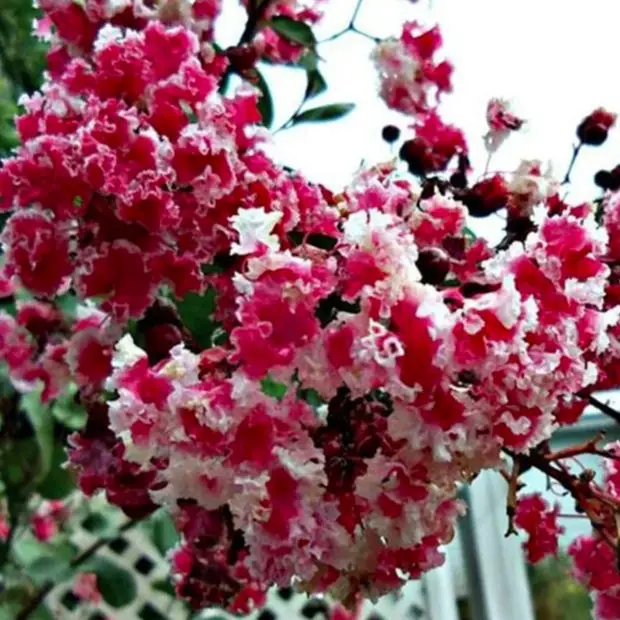Crepe myrtles are treasured for their vibrant blooms and elegant branching, but improper pruning can ruin their natural beauty. If you’ve ever wondered when and how to prune without harming your tree’s structure, you’re not alone.
Understanding the right timing and technique is key to encouraging healthy growth and abundant flowering. In this guide, we’ll walk you through expert tips on pruning crepe myrtles the right way—so your tree thrives season after season with its graceful silhouette intact.
Understanding the Natural Growth of Crepe Myrtle

Crepe myrtles are cherished for their vibrant summer blooms and elegant, sculptural branching. These ornamental trees and shrubs thrive in warm climates and require minimal pruning when correctly maintained. Before making any cuts, it is essential to understand their natural growth habits. Crepe myrtles form flower clusters on new wood, meaning the buds that will bloom in summer are formed on the growth that appears in spring.
By preserving the plant’s natural shape, you ensure structural integrity, encourage healthy blooming, and prevent unnecessary stress. Aggressive or incorrect pruning, often referred to as “crepe murder,” not only diminishes the tree’s appearance but also leads to weaker branches and reduced flowering.
The Ideal Time to Prune Crepe Myrtle
Why Timing Matters
Pruning at the wrong time can reduce the plant’s ability to flower or even expose it to disease. The best time to prune crepe myrtles is in late winter to early spring, just before new growth begins. This allows gardeners to remove old or damaged branches while giving the plant the time it needs to form strong new shoots.
In USDA Zones 7 through 10, late February through March is often ideal, though you should avoid pruning during periods of hard frost. When timed correctly, pruning encourages the crepe myrtle to channel its energy into producing larger flower clusters and a more attractive branch structure.
Avoiding Summer and Fall Pruning
Pruning crepe myrtles in summer or fall can harm the tree more than help. In summer, cutting back branches removes current-season flower buds and stresses the plant, making it more prone to pests and reducing bloom quality.
Fall pruning is even riskier, as it may trigger new growth that won’t survive winter frost, leading to dieback and a weaker structure. It also disrupts the tree’s dormancy and can affect the next year’s flowering.
To protect plant health and preserve its natural cycle, avoid pruning after midsummer. The best time is late winter or early spring, when the tree is dormant and pruning won’t interfere with flowering.
How to Preserve the Natural Form While Pruning
Pruning crepe myrtles is not about forcing a shape—it’s about guiding the plant’s natural beauty. The key to preserving its elegant form lies in selective and minimal intervention. Start by observing the natural branching structure of the tree. Avoid drastic cuts to the main trunks or topping, which leads to unsightly growth and weak limbs in the following seasons.
Begin by removing only what is necessary. Cut away suckers growing from the base of the tree, as well as any inward-facing or rubbing branches. These minor adjustments help open up the canopy, improve air circulation, and enhance the tree’s natural shape. Always prune back to a branch junction or bud—never leave stubs, as they can invite disease and disrupt the visual flow of the branches.
When thinning out the crown, focus on maintaining an open, vase-like structure. Keep the strongest vertical trunks and allow graceful lateral limbs to spread naturally. Use sharp, clean pruning shears and step back frequently to evaluate the overall symmetry and balance.
Never prune more than 20–25% of the canopy in a single session. Excessive cutting not only stresses the tree but also encourages rapid, unattractive regrowth. Pruning should feel like gentle editing, not reconstruction. By following the tree’s natural cues and removing only what’s necessary, you’ll retain the crepe myrtle’s signature beauty and ensure strong flowering year after year
Regional Considerations for Pruning
The right time to prune crepe myrtle varies by region due to climate differences. Understanding your local growing zone is key to timing pruning correctly and preserving the plant’s health and flowering potential.
Southern States (Zones 8–10)
In warm southern states like Texas, Florida, Georgia, and Louisiana, winters are mild and short, and crepe myrtles may not go fully dormant early. Pruning is best done in late winter to early spring (February to early March), when the tree is still dormant but before new growth begins. Avoid pruning in the fall, as warmer temperatures may stimulate new growth that can be damaged by unexpected cold snaps.
Mid-Atlantic and Southeast (Zones 6–7)
In regions like North Carolina, Virginia, and northern parts of Georgia, winters are cooler and longer. Prune in early to mid-March, when the threat of deep frost is mostly past but before bud break. Pruning too early (January–February) risks exposing new shoots to late frost damage. Avoid pruning during the summer, as it can reduce flowering and stress the tree during hot weather.
Northern Regions (Zone 5 and Below)
In colder areas like the Midwest and Northeast (e.g., Michigan, New York, Pennsylvania), crepe myrtles are often at the edge of their hardiness. They may suffer winter dieback. In these regions, pruning should be minimal and delayed until April or later, once it’s clear which branches survived the winter. Never prune in fall or winter, and always protect the base of the plant in winter to prevent cold damage.
Pacific Northwest and Coastal California
In regions like Oregon, Washington, and coastal California, the climate is mild and wet. Pruning can typically be done from late January to early March, when the plant is still dormant. However, prolonged wet conditions can lead to fungal problems, so it’s important to prune on dry days using clean, sharp tools to prevent infections from open wounds.
Correcting Past Pruning Mistakes
Recovering from “Crepe Murder”
If a crepe myrtle has been improperly topped, it may produce numerous thin, vertical shoots that lack the strength of natural branches. Begin by selecting a few healthy shoots to train as new leaders, gradually thinning out the weak stems over several years.
With consistent and patient corrective pruning, the plant can often recover its natural form. Focus on gradual improvement rather than drastic changes, as this reduces stress on the tree and supports its long-term health.
Encouraging Strong New Growth
After pruning in late winter or early spring, support crepe myrtles by applying a balanced fertilizer like 10-10-10 to boost bud development. Water thoroughly to help nutrients reach the roots, and add mulch around the base—keeping it a few inches from the trunk—to retain moisture and control weeds.
Remove weak shoots and suckers early to focus energy on strong branches. Ensure the plant receives full sun, regular water, and good airflow. Avoid overfeeding or overwatering, which can lead to leafy growth without flowers. With proper care, you’ll encourage lush foliage and vibrant blooms all season.
Long-Term Maintenance for Shape and Health
To preserve both the natural shape and vigor of your crepe myrtle over the years, consistent but light annual care is essential. Focus on removing crossing, rubbing, or inward-growing branches each winter to maintain an open canopy. This encourages better airflow, reducing the risk of diseases like powdery mildew and sooty mold.
Every few years, evaluate the structure of the tree to prevent overcrowding in the center and thinning out weak stems that sap energy from stronger growth points. Never cut back large branches to stubs—a practice often referred to as “crepe murder”—as this disrupts the tree’s natural form and weakens future growth.
Regularly check for suckers at the base and remove them early. Apply a slow-release fertilizer in early spring and replenish mulch annually to protect roots and retain moisture. This approach supports not only the aesthetic appeal but also the long-term health and productivity of your crepe myrtle.
Common Mistakes to Avoid
When pruning crepe myrtle, avoiding common mistakes will help keep the tree healthy and beautiful.
One major mistake is topping the tree, or cutting large branches into stubs. This weakens the structure, leads to unattractive growth, and makes the tree more prone to damage. Instead, always follow the tree’s natural branching pattern.
Pruning at the wrong time, such as in late summer or fall, can trigger tender new growth that gets damaged by winter cold. The best time is late winter to early spring, before new growth starts.
Young crepe myrtles should not be heavily pruned. Over-pruning young trees can slow their natural development and delay blooming.
Avoid trying to force the tree into a certain shape. Instead, work with its natural form, removing only crowded, crossing, or weak branches.
Don’t forget to remove suckers at the base, which take energy away from the canopy and change the tree’s shape.
Lastly, always use sharp, clean tools to make smooth cuts and reduce the risk of disease.
By avoiding these mistakes, you’ll support strong growth and enjoy better blooms every year.
FAQ
When is the absolute best time to prune crepe myrtles?
The ideal time to prune crepe myrtles is in late winter to early spring, typically between February and early March, depending on your USDA zone. This is when the plant is still dormant but just about to break dormancy. Pruning at this time allows the plant to channel its energy into producing strong new growth and an abundance of flowers in the coming season. Pruning too early risks frost damage, while pruning too late can interfere with flower development.
What happens if I prune my crepe myrtle too late in spring?
If you prune too late in the spring—after new growth or flower buds have already begun forming—you may inadvertently cut off potential blooms for the season. Crepe myrtles flower on new wood, so pruning after leaf-out can weaken blooming or delay it significantly. Additionally, late pruning may lead to stress in the plant as it redirects energy to compensate for sudden loss of foliage or branches.
Can I prune crepe myrtles in the fall?
Fall pruning is not recommended for crepe myrtles. Cutting the plant back in autumn can stimulate new growth just before winter, which leaves the new shoots vulnerable to cold damage and frost. Instead, let the plant go dormant naturally and save all shaping or structural pruning for late winter. If necessary, you can remove small suckers or seed pods in fall, but avoid any heavy pruning until the dormant season.
What should I do if my crepe myrtle was topped in the past?
Topping, or cutting the main branches back to stubs, is a harmful and outdated practice often referred to as “crepe murder.” If your tree was previously topped, don’t panic—restoration is possible. Allow new shoots to emerge from the cut areas and then selectively thin the weakest or most crowded stems over a few years. Focus on removing cross branches and encouraging one or two strong leaders to grow naturally. This gradual rejuvenation avoids stressing the tree and helps return it to its elegant, vase-shaped form.
Is it necessary to prune crepe myrtles every year?
Annual pruning is optional but beneficial, especially if you’re aiming to maintain a clean structure and stimulate prolific flowering. Each year during dormancy, you can remove any crossing, crowded, or dead wood, along with suckers growing at the base. Avoid excessive pruning, especially of large limbs, unless needed for structural reasons. Light, thoughtful pruning helps the tree maintain its natural shape while improving airflow and sunlight penetration.
Should I cut off the seed pods after blooming?
While not essential, removing spent flowers or seed pods—a process called deadheading—can encourage a second round of blooms in long, warm seasons. You can simply snap off or clip the faded clusters to redirect energy toward new flower production. However, if you’re short on time or prefer a more natural look, leaving the seed heads won’t harm the plant. In some cultivars, the seed pods can even add ornamental interest through late summer and fall.
Conclusion
Pruning crepe myrtle at the right time and in the right way is essential to maintain its natural beauty, promote healthy growth, and ensure vibrant blooms year after year. By understanding your region’s climate, avoiding common mistakes, and focusing on gentle, shape-conscious cuts, you can enjoy a stunning, long-lived crepe myrtle that thrives in every season.






